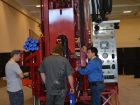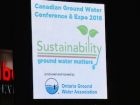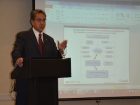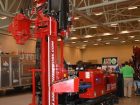
Features
Associations
Business
Highlights from the Canadian Ground Water Conference & Expo 2016
June 14, 2016 By Colleen Cross
The Canadian Ground Water Conference and Expo served as a reminder that drilling for ground water is more than just a day-to-day business. It’s a responsibility and an opportunity to help sustain our environment and the human lives that depend on its health.
The Ontario Ground Water Association, who organized the event, invited Ground Water Canada to be part of the action, and it was an exhilarating experience. The conference and trade show, which took place in Niagara Falls from June 8 to 11, was an ambitious admixture of trade show, educational forum, annual meeting, golf tournament, awards ceremony and industry strategizing.
For the first time since Canwell in 2014, members from across Canada – including contingents from British Columbia, Saskatchewan, Manitoba, Ontario and New Brunswick – met to discuss the business, technical and scientific aspects of bringing ground water to the public.
The national event, organized by the OGWA team led by Craig Stainton and Anne Gammage, served as a hub for those interested in locating, accessing and protecting ground water. Learning about the many complicated aspects of this precious resource took the form of educational sessions, group discussions and entertaining presentations. It also took the form of displays from manufacturers and suppliers of equipment and products.
SEE MORE PHOTOS AT OUR FACEBOOK PAGE (AND “LIKE” US WHILE YOU”RE THERE)!
Lots of high-level and detailed thinking went on at the Marriott Fallsview Hotel and Scotiabank Convention Centre, where the marquee gave ground water high visibility in an international vacation spot.
After a rather cool round of golf Wednesday evening, members were asked at Thursday’s lunch to do some big-picture thinking. Alfonso Rivera, chief hydrogeologist for the Geological Survey of Canada challenged a room full of keenly interested water well drillers, pump installers and hydrogeologists to imagine what a Canada-wide industry association should or look like and what role it should play in the overall scheme of ground water management.
The hydrogeologist, who spent many years with National Resources Canada and was involved in key ground water committee discussions, summarized works published and actions taken by the federal government since the 1980s, culminating in the Council of Canadian Academies’ 2009 recommendations published in The Sustainable Management of Groundwater in Canada. The Canadian Council of Ministers of the Environment is moving forward to implement these recommendations through the provinces, he said. What’s needed is a clear collaborative and co-ordination mechanism for carrying out the report’s ideas, along with more funding, wider sharing of data and more personnel.
Rivera said water well drillers are key partners in accounting for ground water. He encouraged drillers to work more closely with the GSC to share their pumping levels, well records and other data. “The wells are our eyes,” he said.
Rivera also shared details of ambitious ground water mapping projects he has been leading at the GSC. As part of a National Framework for Aquifer and Ground Water Accounting, NRC has mapped 19 of 30 aquifers using remote satellite technologies. By 2019 they expect to have 22 completed, at which point they will begin taking action based on the data they have collected. Assessing and providing ground water use information is a key step in making sure government budgets reflect the quantity and allocation of ground water, Rivera noted.
Those attending the session agreed to the next step of each provincial association appointing a representative to come to the national discussion table. Keeping membership costs down and not making it mandatory for members to belong to their provincial association were two priorities expressed in the meeting.
William M. Alley, science and technology director for the U.S. National Ground Water Association, provided a fascinating overview of ground water sustainability. Alley, who also served as chief of the Office of Groundwater at the U.S. Geological Survey for nearly two decades, defined sustainability and laid bare some of its common myths.
He described sustainability as “the development and use of ground water in a manner that can be maintained for an indefinite time without causing unacceptable environmental, economic, or social consequences.”
Among myths he debunked: ground water and surface water are separate resources, ground water systems are safe as long as pumping doesn’t exceed recharge (in fact, ideally, pumping should at a lower level than recharge), and to manage ground water we need to know exactly how much we have, or “total storage” (in fact, although measurement is important, there are other factors involved, and a small change in levels can have a big impact).
Alley identified pressing challenges as nitrates in Chesapeake Bay and the need to establish total daily maximum load in the face of disagreement between scientists.
Another kind of resource got plenty of attention at the conference: the human resource. During an educational session, Fleming College’s Jim Smith made a convincing argument for well drillers making staff training a high priority. Smith, a professor at the college and head of the resources drilling and blasting program on the retirement of longtime industry liaison Gord Bailey, pointed out that the Internet has made customers far more educated, if not always accurately so. He asked drillers if their staff could adequately answer questions that arise on the jobsite, and, more pointedly, if they had trained their staff to answer them. Effective training involves setting skill objectives, teaching to meet those objectives and assessing the trainee’s retention of the training. It’s important to keep in mind that some people learn by seeing, others learn by hearing and still others learn by doing, he said. Varying teaching methods will address these differences in learning styles.
David Coletto may have opened some minds – and certainly entertained them – with his talk on managing millennials. Coletto is a founding partner and CEO of Abacus Data, a company that focuses on strategies for working with and marketing to the so-called millennial generation encompassing those aged 16 through 36. Millennial Canadians have the same values and goals as their baby-boomer parents – getting married, buying a home, having children and having a steady job – but they express these goals differently, the youthful looking 34-year-old said. Having been raised by, oftentimes, overprotective parents, these young workers need structure, he added. Coletto encouraged an audience largely made up of baby boomers and gen Xers to provide young workers with training and professional development and to offer them regular feedback on their performance.
Saturday was water quality day at the conference, highlighted by talks from the Canadian Water Quality Association’s Kevin Wong on recent regulatory work he and the association are doing on behalf of the water well industry, and Peter S. Cartwright, McElhiney lecturer and technical consultant for the CWQA, on contaminants such as manganese that are threatening water quality.
The trade show, which ran alongside the educational program, gave attendees ample time to talk equipment and products with manufacturers and suppliers. Six shiny rigs and trucks from AMS, Atlas Copco, Eloquip, Nordic Drill, Oak-Land Ford Lincoln Sales and Wellmaster Pipe and Supply provided impressive focal centrepieces for drillers looking to upgrade their equipment and vehicles for transporting it.
Parts and tool manufacturers and suppliers and service providers were on hand on the show floor to provide information and guidance on their products.
Look for more coverage of the conference and trade show at www.groundwatercanada.com and in the Fall issue of Ground Water Canada magazine.
Print this page

















